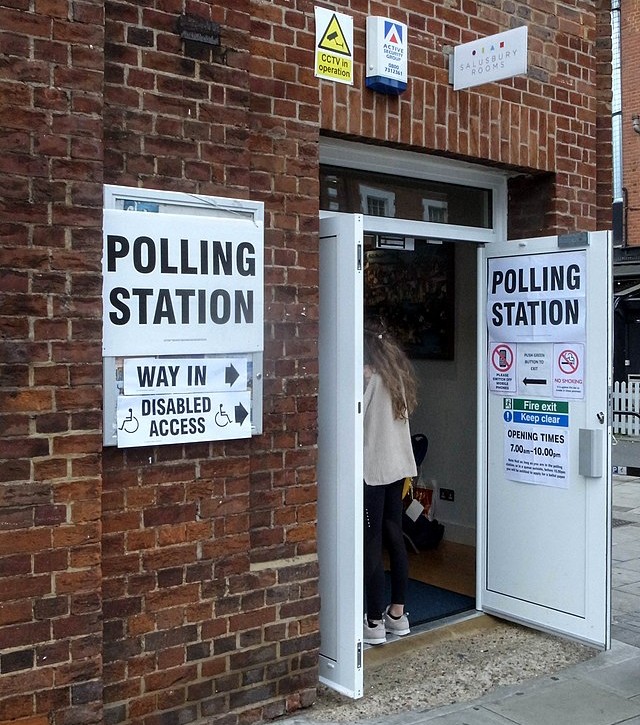“You have to register at home, where your parents live,” said the clerk at the Board of Elections office.
I was 18, and registering to vote for the first time. It was 1972.
“I don’t live there,” I said. “I live here.” “Here” was Ithaca, NY, a town that, I learned later, was hyper-conscious that college students – Cornell, Ithaca College – outnumbered local residents. They didn’t want us interlopers overwhelming their preferences.
We had a couple more back-and-forths like this, and then she picked up the phone and called the state authorities in Albany for an official ruling. I knew – or thought I knew – that the law was on my side.
It was. I registered. I voted.
In about a month, the UK will hold local elections. For the first time, anyone presenting themselves to vote at the polls will be required to show an ID card with a photograph. This is a policy purely imported from American Republicans, and it has no basis in necessity. The Electoral Commission, in recommending its introduction, admitted that the issue was public perception. The big issues with respect to elections are around dark money and the processes by which candidates are chosen.
For 49 days in the fall of 2022, Liz Truss served as prime minister; she was chosen by 81,326 Tory party members. Out of the country’s roughly 68 million people, only 141,725 (out of an estimated 172,000 party members) voted in that contest because, since the Conservatives had decisively won the 2019 election, they were just electing a new leader. Rishi Sunak was voted in by 202 MPs.
The government’s proximate excuse for bringing in voter ID is the fraud-riddled May 2014 mayoral election in the London borough of Tower Hamlets. Four local residents risked their own money to challenge the outcome, and in 2015 won an Election Court ruling voiding the election and barring the cheating winner from standing for public office for five years. Their complaints; included vote-rigging, false statements made by the winning candidates about his rival, bribery, and religious influence.
The High Court of Justice’s judgment in the case says: “…in practice, where electoral malpractice is established, particularly in the field of vote-rigging, it is very rare indeed to find members of the general public engaging in DIY vote-rigging on behalf of a candidate. Generally speaking, if there is widespread personation or false registration or misuse of postal votes, it will have been organised by the candidate or by someone who is, in law, his agent.”
Surely a more logical response to the Tower Hamlets case would be to make it easier – or at least quicker – for individuals to challenge election results and examine ways to ensure better behavior by *candidates*, not voters.
The judgment also notes that personation – assuming someone else’s identity in order to vote – was far more of a risk when fewer people qualified to vote. There followed a long period when it was too labor-intensive for too little reward; you need a lot of impersonators to change the result. In recent years, however, postal voting has made it viable again; in two wards of a 2008 Birmingham election Labour candidates committed 15 types of fraud involving postal ballots. The election in those two wards was re-run.
In his book Security Engineering, Cambridge professor Ross Anderson notes that the likelihood that expanded use of postal ballots would open the way for vote-buying an intimidation was predicted even as first Margaret Thatcher and then Tony Blair pursued the policy. But the main point is clear: the big problem is postal ballots, which you can’t solve by requiring voter ID from those who vote in person. It’s the wrong threat model. As Anderson observes, “…it’s typically the incumbent who tweaks the laws, buys the voting machines, and creates as many advantages for their own side, small and large, as the local political culture will tolerate.”
But voter ID is the policy that Boris Johnson used his 80-seat majority to push through in the form of the Elections Act (2022), which also weakens the independence of the Electoral Commission. As the bill went through Parliament, estimates were that about 3.5 million people lacked any qualifying form of ID, and that those 3.5 million skew heavily toward people who are not expected to vote Conservative.
This was all maddening enough – and then they published the list of acceptable forms of ID. Tl;dr: the list blatantly skews in favor of older and richer people, who are presumed to be more likely to vote Conservative. Passports, driving licenses, and travel passes 60+ for people are all acceptable. Student ID cards and travel cards and passesare not. The government says they are not secure enough, a bit like saying a lock on the door is pointless because it’s not a burglar alarm.
There is a scheme for issuing free voter cards; applications must be in by April 25. People can also vote by post or by proxy without ID. And there are third parties pushing paid ID cards, too. But what it comes down to is next month a bunch of people are going to go to vote and will be barred. And this from the same people who wanted online voting to “increase access”.
Illustrations: London polling station 2017 (by Mramoeba at Wikimedia.
Wendy M. Grossman is the 2013 winner of the Enigma Award. Her Web site has an extensive archive of her books, articles, and music, and an archive of earlier columns in this series. Follow on Mastodon or Twitter.

One thought on “Excluding the vote”